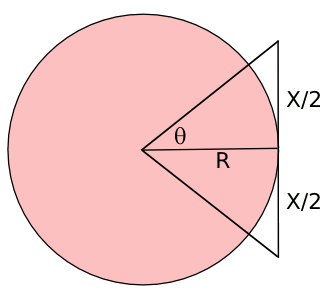Pi Day
March 14, 2012
Today is "
Pi Day" (3.14). I wasn't among the many fans who likely stayed awake until 1:59 AM to get those last extra
decimal digits, but I'm still a big fan of the
mathematical constant, pi.
Pi appears to be an important part of the
physical universe, since it appears in so many
fundamental equations of
physics. For example, the
Einstein field equations of
general relativity contain the constant (8πG/c
4).
Pi must have weighed heavily on my mind in
2010, since I wrote three articles about it.
• Buffon's Needle, July 19, 2010
• Another Piece of Pi, July 28, 2010
• Pi is Forever, September 23, 2010
The last article somehow made it to the fourth page of 43,400 results on
Google when I searched for
hex digits of pi. It must be a niche area. More on
hex digits of pi later in this article.
The first accurate estimates of pi were done by
Archimedes, who used a
geometrical approach of approximating a circle by inscribed and circumscribed
polygons (see figure). You can do this for
regular polygons of any number of sides, but Archimedes was limited to those with special angles, such as 30 degrees, for which he could calculate the
tangent.
Today, using
trigonometric tables, we can do this for any regular polygon. This doesn't make that much sense, since the trigonometric functions are calculated by
series expansions, and so is pi.

Principle behind the calculation of pi using a circumscribed polygon.
(Rendered by the author using Inkscape)
Using Archimedes' method, it's a simple matter to get the
perimeters P of the polygons and ratio them to the
radius R of the circle to get
π ≈ P/(2R),
Archimedes was able to calculate our
elementary school value of pi, 22/7, using a circumscribed 96-sided polygon.
Ptolomey did the same with a 360-sided polygon, getting the value, 3.141666..., that's correct to three decimal places.
Computer techniques have allowed a calculation of pi to
10,000,000,000,050 decimal digits. This was done by Shigeru Kondo, a
Japanese systems engineer, on home-built hardware. This is truly overkill. Our present estimate of the
diameter of the universe is 93 billion
light-years (8.8 x 10
26 meters), so we only need twenty-seven digits of pi to calculate the circumference of the universe to better than a meter, and thirty-eight digits to get a value of the circumference closer than the
size of an atom.
In the past, if you wanted the
n-th digit of pi, you needed to calculate all the digits leading up to n. This changed in 1997, when
David Bailey,
Peter Borwein and
Simon Plouffe (BBP) published a
formula that allows calculation of any digit of pi without calculation of all the preceding digits.[1-3]

As the 16
k term probably tipped you off, the equation gives pi in hexadecimal form.
I've posted
C source code for calculation of the first 20,000 hex digits of pi in a previous article, but it's worth a few extra
electrons to post the source code of an
improved version. It's based on code published by David Bailey,[4] and it will calculate these 20,000 hex digits in under a minute on most computers.
Mathematician,
Clifford Pickover, published an interesting
conjecture in May, 2003.[5] This conjecture, which depends on the digits of pi being truly
random,[6] is as follows:
"Somewhere inside the digits of pi is a representation for all of us -- the atomic coordinates of all our atoms, our genetic code, all our thoughts, all our memories. Given this fact, all of us are alive, and hopefully happy, in pi. Pi makes us live forever. We all lead virtual lives in pi. We are immortal."
You can try to find parts of yourself in pi, at
this web site.[7]
References:
- David H. Bailey, Peter B. Borwein and Simon Plouffe,"On the Rapid Computation of Various Polylogarithmic Constants". Mathematics of Computation, vol. 66, no. 218 (April 1997), pp. 903-913.
- David H. Bailey, "The BBP Algorithm for Pi, September 17, 2006
- Tsz-Wo Sze, "The Two Quadrillionth Bit of Pi is 0! Distributed Computation of Pi with Apache Hadoop," arXiv Preprint Server, August 18, 2010.
- David H. Bailey, "BBP Code Directory" (Updated September 8, 2006)
- Cliff Pickover, "We are in Digits of Pi and Live Forever," May 2003.
- David Whitehouse, "How random is pi?," BBC News, July 23, 2002.
- David G. Andersen, The Pi Searcher Web Site
- David Blatner, Joy of Pi Web Site.
- Eric W. Weisstein, "Pi Digits." From MathWorld--A Wolfram Web Resource.
Permanent Link to this article
Linked Keywords: Pi Day; decimal digits; mathematical constant, pi; physical universe; fundamental equations; physics; Einstein field equations; general relativity; 2010; Buffon's Needle, July 19, 2010; Another Piece of Pi, July 28, 2010; Pi is Forever, September 23, 2010; Google; hex digit; Archimedes; geometry; polygon; regular polygon; tangent; trigonometric tables; series expansion; Inkscape; perimeter; radius; elementary school; Ptolomey; 10,000,000,000,050 decimal digits; Japanese; diameter of the universe; light-year; meter; size of an atom; David Bailey; Peter Borwein; Simon Plouffe; formula; C source code; electron; Clifford Pickover; conjecture; random.